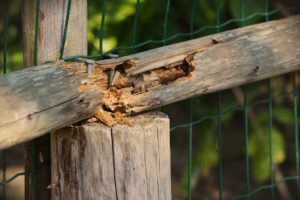 Even in drought-stricken Southern California wood rot caused by water is damaging structures on both commercial and residential property. Rotten wood caused by moisture can be easy to miss, especially when the seasons have been as dry as they have been over the last 10 years. It’s also easy to put off the repairs – for some of us the drought makes dealing with wood rot seem like a back burner project. It’s easy to ignore the problem when we aren’t expecting wet weather.
Even in drought-stricken Southern California wood rot caused by water is damaging structures on both commercial and residential property. Rotten wood caused by moisture can be easy to miss, especially when the seasons have been as dry as they have been over the last 10 years. It’s also easy to put off the repairs – for some of us the drought makes dealing with wood rot seem like a back burner project. It’s easy to ignore the problem when we aren’t expecting wet weather.
Water-caused rot develops when moisture lingers on wooden surfaces that are unprotected. The lack of protection happens when wooden structures are not repainted regularly or resealed after a period of time. The moisture will settle into unprotected cracks and crevices and that creates a fantastic environment for fungi – the real culprit of the wood rot. Wood rot only needs 20 percent moisture content to live. That means it can show up in all but the most arid temperature zones.
There are several different kinds of fungi that contribute to wood rot. Brown rot, white rot and soft rot. Brown-rot fungi break down the wood by digesting the cellulose in the wood. Through the chemical reaction of the fungi’s digestive process, hydrogen peroxide is produced and it diffuses through the wood leading to wood shrinkage and cracking. This type of rot is often generalized as dry rot, but since the wood is often not damp during the process the reference is outdated. In fact, most types of brown rot are colloquially known as dry rot. White rot is similar to brown rot, as it breaks down cellulose. However white rot leaves the wood springy or spongy, and leaves light-colored lignin in the wood which causes the whitish appearance. Soft rot breaks down cellulose in wood and leaves small cavities in the word which discolors and cracks wood in a way similar to brown rot. Soft rot is often found in hotter areas where brown and white rot are unable thrive, and it is usually less aggressive when it comes to rot.
Preventing Wood Rot
Should wood rot infest your wooden structures, there are very few options for resolution. You can repair the wood, replace it or treat it. Leaving it untreated could allow the rot to spread and lead to structural damage. It also could lead to termite infestations.
So, how can you find out if you have wood rot? Get out your binoculars, a flashlight and a screwdriver – you’ll be hunting it down using good old fashioned detective work. You’ll be looking for wood that is discolored or soft. Your wooden structures should not be soft to a firm press of the thumb. The wood should not be crumbling. If the paint is peeling investigate that area with your screwdriver. Keep an eye open for any areas that seem to be constantly exposed to water, say from an air conditioning unit placed in a window. Windowsills, doorframes and decks are notorious for harboring wood-rot fungi.
Once you find wood rot, either treat it with a chemical such as borate or replace the wood entirely. In order to prevent an infestation of wood-rot fungi in your existing structure, follow these tips:
- Use a dehumidifier if your basement has a moisture level of over 50 percent
- Repair plumbing leaks as soon as possible
- Address any leaks in your roof right away
- Remove leaves and sticks from any rain gutters
If you’re building a new structure, be sure to follow these tips:
- Build on a well-drained property that has been graded properly
- Install roof overhang gutters so that water does not seep under your structure
- Install untreated wood at least 18 inches from the ground
- Place vapor barriers on soil surfaces under your structure
If you decide you need to replace the structure, Helfrich-Associates can assess that decision and let you know whether or not you have a problem that needs that level of resolution.
Have you been dealing with wood rot on your property? How has it affected your home or business? Let us know in the comments below.
You can also join in on the conversation on our Facebook, Twitter or LinkedIn pages.
